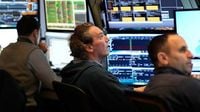U.S. Stock Market Gains After Fed's Interest Rate Decision
Positive trends in Nasdaq, Dow Jones, and S&P 500 reflect investor optimism.
In a surprising burst of momentum, all three major U.S. stock indices—the Nasdaq Composite, Dow Jones Industrial Average, and S&P 500—closed in positive territory on March 19, 2025, following the Federal Reserve's decision to hold interest rates steady at 4.5%. This decision has fueled optimism among investors, contributing to a day of significant gains in equity markets.
The Nasdaq Composite led the charge with an impressive upswing of 1.4%, marking its best performance during a Federal Reserve meeting since July. Tech stocks, specifically, found robust support as investors reacted positively to comments from Fed Chairman Jerome Powell during his press conference.
"The central bank aims to balance economic growth with inflationary pressures, and we believe this pause on interest rates is a positive sign for tech enterprises which have faced challenges recently," said Julie Hyman, host of Yahoo Finance's Market Domination Overtime.
The enthusiasm did not stop at the Nasdaq. The Dow Jones Industrial Average rose by 0.9% while the S&P 500 climbed 1%. These shifts were backed by strong performances from notable stocks within these indices.
In particular, Nvidia, a leader in the AI sector, reported a 1.8% increase to its stock price, with a market valuation soaring to $2.9 trillion following the revelation of new technological advances in AI chips. Tesla saw a remarkable resurgence of 4.7%, while Google's parent company, Alphabet, gained 2% partly due to its recent $32 billion acquisition of Israeli cybersecurity firm Wiz.
Investors remain cautious but optimistic about future monetary policy predicted by Powell, who indicated that two cuts in borrowing costs could occur later in the year.
As of March 20, 2025, the U.S. stock market continues to navigate a landscape marked by economic fluctuations and geopolitical tensions. Investors are closely observing the performance of major indices, including the NASDAQ 100, Dow Jones 30, and S&P 500.
The NASDAQ 100 comprises non-financial companies with a strong emphasis on technology. The index reflects current trends in the tech sector's performance, underlining persistent inflation and rising interest rates that challenge growth-oriented stocks. Yet, with strong demand for digital solutions, particularly in areas like cloud computing and cybersecurity, growth potential remains robust within this sector.
The Dow Jones maintains stability as it encompasses a diverse range of industries. Recent economic data suggesting modest growth has, in turn, supported investor confidence among blue-chip stocks—an encouraging sign during times of uncertainty. Corporate recovery efforts and increased consumer spending are expected to fuel further growth in this index.
Meanwhile, the S&P 500's fluctuations showcase a blend of strong and weak performances across varied sectors. Some areas, especially technology and consumer discretionary, are thriving, while challenges persist in sectors such as energy and utilities.
Critical economic indicators—GDP growth, inflation rates, and employment figures—inform market trajectories, shaping investor sentiment. Persistent inflation looms as a concern, raising expectations of possible monetary policy adjustments by the Fed. Thus, the potential impact of employment data remains paramount: strong (or weak) job growth can signal an economic landscape ripe for (or hindered by) consumer spending.
Global trade relations and geopolitical developments bear close watching too, as they can create uncertainty in the market landscape. Changes in tariffs or trade agreements prompt investors to reassess their risk exposure.
As the indices reflect different facets of the U.S. economy, the future outlook remains cautiously optimistic. With significant ongoing innovation, particularly in the technology sector, the Nasdaq 100 is projected to thrive in the long run, even amid pressures from potential interest rate hikes.
Moreover, stability in the Dow might attract risk-averse investors, especially with the historical performance demonstrating preference for its defensive characteristics against market fluctuations, while the S&P 500 remains a telltale sign of market sentiment shifting between diverse sectors.
In summary, the U.S. stock market's performance highlights resilience amid economic uncertainties, shaped by the Federal Reserve's policies and global events. Investors are keeping a close eye on how these movements could influence their strategies as the performance of the tech-heavy Nasdaq continues to shine in light of renewed investor enthusiasm.






